Robert and Christina
Go to Hawaii
Part 4: Pre-Volcanic Delights in
and around Hilo (The Big Island)
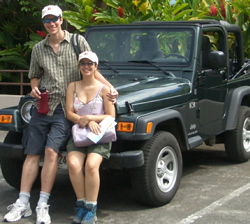 On
Wednesday we woke up spontaneously at 5:26 in the morning—almost an hour
later than the day before. We cheered our jet-lagged bodies, and leapt up to
dress and take our free minivan shuttle to the airport for our two-day trip
to another island. Once through security, we looked around for food options
before our flight, and we noticed a lengthy line at the Chinese place. Investigating,
we discovered big bao—to us, though Hawaiians call them manupuas, a corruption
of the Hawaiian terms for “little yummy things,” or mea ono pua’a.
So, a chicken manupua and a lap-chung hot-dog-like wrap later, we were much
happier, fuller, and ready for our flight. Why don’t mainland airports
have such nice breakfast options?
On
Wednesday we woke up spontaneously at 5:26 in the morning—almost an hour
later than the day before. We cheered our jet-lagged bodies, and leapt up to
dress and take our free minivan shuttle to the airport for our two-day trip
to another island. Once through security, we looked around for food options
before our flight, and we noticed a lengthy line at the Chinese place. Investigating,
we discovered big bao—to us, though Hawaiians call them manupuas, a corruption
of the Hawaiian terms for “little yummy things,” or mea ono pua’a.
So, a chicken manupua and a lap-chung hot-dog-like wrap later, we were much
happier, fuller, and ready for our flight. Why don’t mainland airports
have such nice breakfast options?
Our Aloha Airlines flight to Hilo,
on the so-called Big Island, was short and efficient, with great views of Maui,
Molokai, the Big Island’s Kona coast, and two waterfalls close to Hilo.
Upon landing, we raced off the plane and through the very small, mostly open-air
airport to the open-air rental car counter to pick up our green Jeep Wrangler,
which we immediately turned into a convertible for the day. We drove to the
Hilo Hawaiian Hotel on Banyan Drive, in between the airport and downtown Hilo,
near a pretty Japanese garden and the bay’s Coconut island, with the peak
of Mauna Kea sometimes visible in the distance. The hotel let us check in at
just 9:30, so we repacked one of the two backpacks we’d brought with us,
leaving our overnight things at the hotel and only taking bathing suits and
binoculars with us for the day.
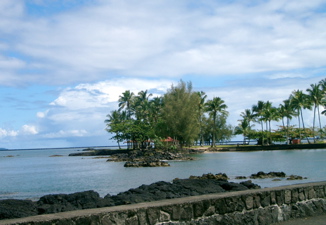
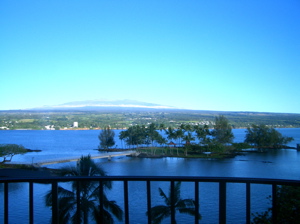
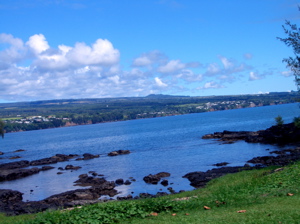
After directions from
the helpful bell captain, we drove into town to hit the famous Hilo Farmers’
Market on Wednesday, one of its two biggest days. In the sweltering 90-plus-degree
weather, with very high humidity, we parked less than a block from the market
and were disinclined to walk any further no matter what. Everyone at the market
was friendly, and many people—including the hippie with goat cheese and
the poor truffle woman trying to keep her chocolate solid—offered samples.
We bought homemade guava jam; Pirie and Hayden mangoes; longan; fried coconut
mochi on a stick; five long, cigar-shaped leaf-wrapped lengths of brown-sugar-sweetened
sticky rice; roasted garlic artisan sourdough bread; and fresh-squeezed lemonade.
The ice in our water bottle, refilled at the hotel, had by now melted, as we
were. In the heat, we drove the two blocks to Two Ladies’ Kitchen, a homemade
mochi place I had read about. We bought an eight-piece assorted mochi box and
a half-dozen box of strawberry mochi, which actually contained seven, not six,
big fat fresh white mochi (glutinous rice dough) containing crushed red beans
around a whole, ripe strawberry. They were marvelous, fresher and better than
any mochi we’d ever had, and more than half our supply was finished in
the next hour as we drove along.
We circled around downtown Hilo,
stopping briefly at a Japanese grocery to buy a fruit knife for our mangoes.
The women in the store loved Robert, giving him directions to a mango tree in
a park in town to try to pick our own, and telling him how the locals love to
eat mangoes (either with salt and sugar, or with vinegar and chilies, according
to them). After a quick stop at a kayakers’ pavilion on the bay to eat
our first-ever ambrosial Pirie mango—a greenish, firm, fist-sized knob
of bliss—we then headed south slightly. Hilo is an interesting, faded-looking,
hippie town, which made us wonder what country we were in and what decade. If
Berkeley, California, and Burlington, Vermont, had suddenly gone tropical, we
would expect them to look like Hilo.
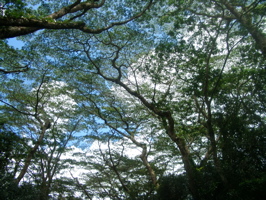
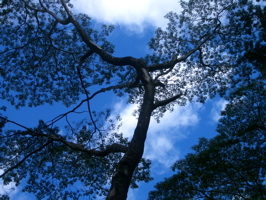
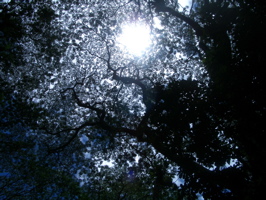
Three views up
from our moving Jeep.
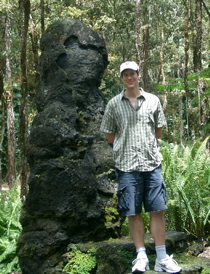
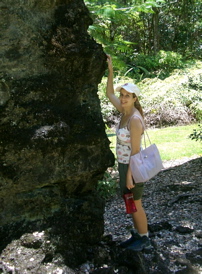 We
drove through to Pahoa, and then through thick forests and rainforests to Lava
Tree State Monument, the remnants of a 1790 lava flow which ate up palm-tree
forests, turning the trees into tree-shaped lava shells. Fresh vegetation in
the last 200 years has started sprouting out of the tops or sides of these lava
cones, resulting in weird, alien-like forms all over this 10-minute, level walk.
Though we were somewhat terrified by the total isolation—like in a horror
movie, we saw only one other car, and no actual people, yet we heard cracking
sounds in the brush and saw strange shadows (birds?)—we highly recommend
the stop. The lava formations were impressive, and some of the ferns and plants
seemed straight out of dinosaur times, never mind the 18th century. Below, Robert
as a dinosaur approaches a particularly tasty-looking fern.
We
drove through to Pahoa, and then through thick forests and rainforests to Lava
Tree State Monument, the remnants of a 1790 lava flow which ate up palm-tree
forests, turning the trees into tree-shaped lava shells. Fresh vegetation in
the last 200 years has started sprouting out of the tops or sides of these lava
cones, resulting in weird, alien-like forms all over this 10-minute, level walk.
Though we were somewhat terrified by the total isolation—like in a horror
movie, we saw only one other car, and no actual people, yet we heard cracking
sounds in the brush and saw strange shadows (birds?)—we highly recommend
the stop. The lava formations were impressive, and some of the ferns and plants
seemed straight out of dinosaur times, never mind the 18th century. Below, Robert
as a dinosaur approaches a particularly tasty-looking fern.
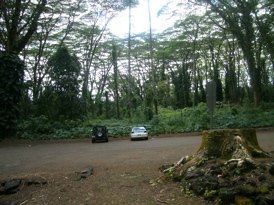
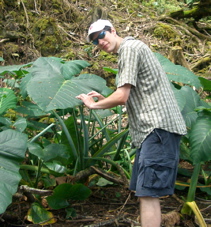
Next, we attempted to go to Green
Crater Lake, an idyllic swimming hole my Lonely Planet guidebook gave detailed
directions to. The directions involved parking by the side of the road at a
certain unmarked point, then walking into a field and through a fruit-tree forest,
then down a winding path on the slopes of the crater walls to the lake. We kept
losing the path, though, and my 20-year-old Girl Scout compass came in handy
for noting which direction we had come from in case we couldn’t tell how
to return. There wasn’t a single other person around, but the crushed
fruit from the trees, and the dense tropical vegetation, attracted what felt
like thousands of mosquitoes—who immediately started biting me with abandon.
Robert pronounced them “beautiful” and “colorful” and
“interesting” mosquitoes, but I was not impressed. I was glad of
my hiking boots, since despite the lost path, the scratches on my legs from
the vines and grasses, and the many, many, many insect bites, at least my ankle
didn’t turn, leaving me (as I could see vividly in my mind) sprawled on
the ground with Robert explaining he would go for help.
The lake when we
finally made it. 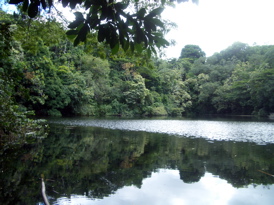
Eventually, we made it to the lake,
which was completely deserted. I found a less-fruity log, spread out a towel,
and sat down, refusing even to touch the water, which bubbled in some places
and looked like Nessie might emerge any second. Braver than I, though not by
much, Robert took off his shoes and socks and waded about two steps into the
lake before deciding that the spongy bottom, bugginess, desertedness, and general
creepiness, was not for him either.
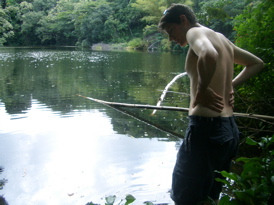 Robert
looks at the lake skeptically.
Robert
looks at the lake skeptically.
We turned around and found our way
back out, to our great relief, meeting, on the way out, a single crunchy-looking
young guy on his way down to swim.
Almost out--I clutch
water, my pocketbook, and a towel and sprint for the Jeep. 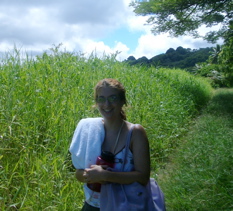
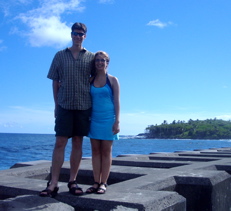
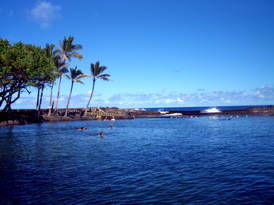 From
there, we drove straight to the unmarked, yet peopled, Ahalanui Beach Park (left)—a
hot pond fed by thermal hot springs, with an outlet into the ocean. Clean and
warm and shady, it was great, and after we changed into our bathing suits in
the Jeep (better than a portapotty for that purpose, I decided), we joined the
15 or so people lounging around and floating in the pool. We felt much more
at home here—there was even a lifeguard, and there weren’t any odd
insects. After a nice swim, we moved on, down the road to the coast, to Isaac
Hale Beach Park, a black-sand volcanic beach where not much swimming actually
seemed possible. There were some surfers, and then, beyond the breakwater (right),
a few kids playing on the boat ramp, but the water was far too rough, and the
“beach” not really ideal for sitting or walking or swimming.
From
there, we drove straight to the unmarked, yet peopled, Ahalanui Beach Park (left)—a
hot pond fed by thermal hot springs, with an outlet into the ocean. Clean and
warm and shady, it was great, and after we changed into our bathing suits in
the Jeep (better than a portapotty for that purpose, I decided), we joined the
15 or so people lounging around and floating in the pool. We felt much more
at home here—there was even a lifeguard, and there weren’t any odd
insects. After a nice swim, we moved on, down the road to the coast, to Isaac
Hale Beach Park, a black-sand volcanic beach where not much swimming actually
seemed possible. There were some surfers, and then, beyond the breakwater (right),
a few kids playing on the boat ramp, but the water was far too rough, and the
“beach” not really ideal for sitting or walking or swimming.
back
------------------------ next
 On
Wednesday we woke up spontaneously at 5:26 in the morning—almost an hour
later than the day before. We cheered our jet-lagged bodies, and leapt up to
dress and take our free minivan shuttle to the airport for our two-day trip
to another island. Once through security, we looked around for food options
before our flight, and we noticed a lengthy line at the Chinese place. Investigating,
we discovered big bao—to us, though Hawaiians call them manupuas, a corruption
of the Hawaiian terms for “little yummy things,” or mea ono pua’a.
So, a chicken manupua and a lap-chung hot-dog-like wrap later, we were much
happier, fuller, and ready for our flight. Why don’t mainland airports
have such nice breakfast options?
On
Wednesday we woke up spontaneously at 5:26 in the morning—almost an hour
later than the day before. We cheered our jet-lagged bodies, and leapt up to
dress and take our free minivan shuttle to the airport for our two-day trip
to another island. Once through security, we looked around for food options
before our flight, and we noticed a lengthy line at the Chinese place. Investigating,
we discovered big bao—to us, though Hawaiians call them manupuas, a corruption
of the Hawaiian terms for “little yummy things,” or mea ono pua’a.
So, a chicken manupua and a lap-chung hot-dog-like wrap later, we were much
happier, fuller, and ready for our flight. Why don’t mainland airports
have such nice breakfast options? 






 We
drove through to Pahoa, and then through thick forests and rainforests to Lava
Tree State Monument, the remnants of a 1790 lava flow which ate up palm-tree
forests, turning the trees into tree-shaped lava shells. Fresh vegetation in
the last 200 years has started sprouting out of the tops or sides of these lava
cones, resulting in weird, alien-like forms all over this 10-minute, level walk.
Though we were somewhat terrified by the total isolation—like in a horror
movie, we saw only one other car, and no actual people, yet we heard cracking
sounds in the brush and saw strange shadows (birds?)—we highly recommend
the stop. The lava formations were impressive, and some of the ferns and plants
seemed straight out of dinosaur times, never mind the 18th century. Below, Robert
as a dinosaur approaches a particularly tasty-looking fern.
We
drove through to Pahoa, and then through thick forests and rainforests to Lava
Tree State Monument, the remnants of a 1790 lava flow which ate up palm-tree
forests, turning the trees into tree-shaped lava shells. Fresh vegetation in
the last 200 years has started sprouting out of the tops or sides of these lava
cones, resulting in weird, alien-like forms all over this 10-minute, level walk.
Though we were somewhat terrified by the total isolation—like in a horror
movie, we saw only one other car, and no actual people, yet we heard cracking
sounds in the brush and saw strange shadows (birds?)—we highly recommend
the stop. The lava formations were impressive, and some of the ferns and plants
seemed straight out of dinosaur times, never mind the 18th century. Below, Robert
as a dinosaur approaches a particularly tasty-looking fern.


 Robert
looks at the lake skeptically.
Robert
looks at the lake skeptically.

 From
there, we drove straight to the unmarked, yet peopled, Ahalanui Beach Park (left)—a
hot pond fed by thermal hot springs, with an outlet into the ocean. Clean and
warm and shady, it was great, and after we changed into our bathing suits in
the Jeep (better than a portapotty for that purpose, I decided), we joined the
15 or so people lounging around and floating in the pool. We felt much more
at home here—there was even a lifeguard, and there weren’t any odd
insects. After a nice swim, we moved on, down the road to the coast, to Isaac
Hale Beach Park, a black-sand volcanic beach where not much swimming actually
seemed possible. There were some surfers, and then, beyond the breakwater (right),
a few kids playing on the boat ramp, but the water was far too rough, and the
“beach” not really ideal for sitting or walking or swimming.
From
there, we drove straight to the unmarked, yet peopled, Ahalanui Beach Park (left)—a
hot pond fed by thermal hot springs, with an outlet into the ocean. Clean and
warm and shady, it was great, and after we changed into our bathing suits in
the Jeep (better than a portapotty for that purpose, I decided), we joined the
15 or so people lounging around and floating in the pool. We felt much more
at home here—there was even a lifeguard, and there weren’t any odd
insects. After a nice swim, we moved on, down the road to the coast, to Isaac
Hale Beach Park, a black-sand volcanic beach where not much swimming actually
seemed possible. There were some surfers, and then, beyond the breakwater (right),
a few kids playing on the boat ramp, but the water was far too rough, and the
“beach” not really ideal for sitting or walking or swimming.